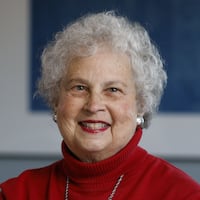“We’re trying to make sure a consumer has access to qualified midwives to help them in their home birth,” said Devon Horsman of Kettering, a certified professional midwife who serves as legislative chair for the Ohio Midwives Alliance.
A report released in March by the National Center for Health Statistics studying two-year periods show there was a 3.5 percent increase in the number of home births from 2003-04 to 2005-06 in the U.S. In Ohio, 1,888 babies were born at home from 2005-2006.
Dayton physician Evangeline Andarsio, a delegate for the Ohio State Medical Association, said her organization would have to review any potential legislation before taking a stand on the issue “but would most likely be opposed to the legislation to license midwives in Ohio.”
“It’s safest for the health of the mother and the baby to be in a medical facility with immediate access to qualified medical professionals equipped with lifesaving medical equipment,” she said.
Horsman cites a 2005 study published in the British Journal of Medicine that found out-of-hospital births to be as safe for low-risk women as a hospital birth when attended by a qualified midwife.
Jennifer Hall of Fairborn was born at home 29 years ago and has carried on that tradition with her two children. She said her own research convinced her there would be less intervention and less likelihood of a Caesarian section at home.
Pregnant women wishing to gain information about a home birth option and those who are qualified to perform it will have a harder time finding what they’re looking for in the state of Ohio.
National statistics show that a greater number of women are having babies at home, but the practice is unregulated in Ohio because the state doesn’t license home midwives.
The only midwives currently recognized by the state are Certified Nurse Midwives who attend nursing schools and collaborate with physicians and hospitals.
According to the National Center for Health Statistics, 95 percent of midwife deliveries in Ohio in 2006 occurred in hospitals.
Finding an experienced midwife for her first child’s birth was easy for Jennifer Hall.
She and her husband were living in New Mexico at the time, so they just opened the phone book and looked under “midwives.” They found and interviewed someone they liked and ultimately had a positive home birthing experience.
It wasn’t that simple the next time around when the family was living in Fairborn.
“Around here, you had to know the right people in order to find a good midwife,” Hall explained. “It was about finding a friend who knew a friend. And because in this state we don’t have licensure, you don’t really know what you’re getting into, and it’s really hard to determine if someone has the level of experience you want.”
That level of experience is offered, she said, by a Certified Professional Midwife who has received both educational and clinical training in an out-of-hospital setting in keeping with the standards of the North American Registry of Midwives (NARM).
Devon Horsman of Kettering has those credentials and now serves as chair for the Ohio Midwives Alliance. The group is actively seeking sponsors for a bill that will recognize the CPM designation.
“Home births are happening, it’s not something people are seeking permission to do,” Horsman said. “We believe that nationally the tide is moving in this direction, more than half the states now recognize Certified Professional Midwives and the number of families having their babies at home has been increasing significantly.”
Across the nation 49,438 babies were born at home in 2005 and 2006 combined. In Ohio, 1,888 were born at home in the same two-year time period.
The reasons families want to give birth at home, Horsman said, may be religious, cultural or economic. The cost of a midwife in the Miami Valley may range from $1,500 to $2,000 and includes prenatal visits, the birth itself and follow-up checkups. The fees are not covered by insurance.
“I really think that people want to know what all their options are and then make the decision that’s best for their family,” Horsman said.
The American Medical Association and the Ohio State Medical Association are among the organizations that take issue with the idea of licensure for midwives in a home setting. They do support Certified Nurse Midwives who work in collaboration with an obstetrician in a hospital.
Jeff Smith, director of government relations for the Ohio State Medical Association, said obstetricians have specific education, residency requirements, training and experience that prepare them for a delivery of a baby in every type of situation.
“They are prepared for complications and we have modern medical facilities that have significantly reduced the number of complications and are readily available to address issues during the birthing process that have not been foreseen,” he said. “Why would we encourage individuals to have home deliveries when we’ve done so much to advance medical care in this state and in this country?”
Stacey Kerr, a retired family practice doctor in California with a background in midwifery, believes normal childbirth is best attended by experienced midwives who understand normal childbirth.
However, she said, it’s “a crapshoot” when it comes to choosing a midwife in a state without licensure.
“If you don’t license, you don’t have any way to know who hung a shingle without experience or training and who has been well trained, well prepared, and well supported. A good midwife knows her limitations and is backed up by a specialist.”
April Kline of Kettering is a midwife who is no longer in practice, but is serving as statewide coordinator for the Ohio Physicians for Midwives, a branch of Ohio Families for Safe Birth.
“The tipping point has been reached and there are now 26 states that recognized licensed midwives,” she said.
“I think Ohio is going to be behind the curve if they don’t jump on this in the next year.”
Contact this reporter at (937) 225-2440 or MMoss@coxohio.com.
About the Author
